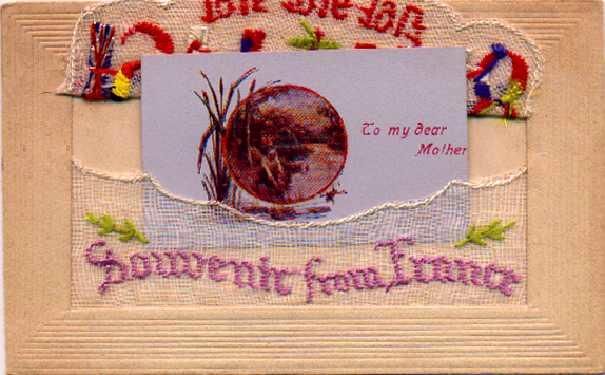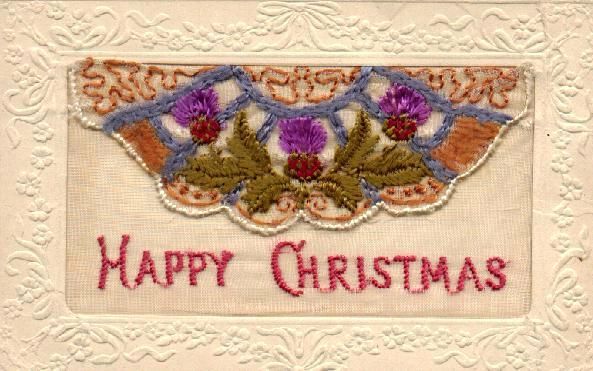Embroidered Silk Postcards

These postcards were produced both by hand and by embroidery machines (invented in approximately 1828, but not widely used until approximately 1850 – these were massive machines and were used in factories, rather than home use).
By the time that embroidered postcards became extremely popular a newer type of embroidery machine had been invented which could cope with up to 6 colours of thread, and that could be used in a home – provided the home had a large enough room. Embroiderred postcards were lucrative enough that a family would invest in the cost of the machine, and the whole family would be involved in the manufacture of the cards.
Embroidered postcards were worked on gauze in long strips – there have been rolls containing up to 400 identical designs found. These were then sent to a manufacture (if made by a home-based factory) for assembly. There, the postcards were cut apart and mounted on stiff card, and the back was able to be used for the message and address. As you can see from the examples below, the mounting is much the same as we use today for making embroidered cards. Most of the cards were made in France and Belgium.
Once the craze for these postcards ended, many family businesses produced strips and panels of embroidery for clothing and linen.
Some of these cards included a small pocket into which a card with a message could be inserted.
These postcards were not what we think of a postcard – a “view”. Instead they carried images of flowers, messages and, during World War 1, propaganda messages and flags of the allied nations.
During World War 1, the target market for embroidered postcards were soldiers – there are postcards surviving that show the price as being approximately 3 cents each – so designs were targeted to appeal to their patriotism, and many cards had the same design and sentiment – only the flags of the nation of the closest soldiers were changed!
After the war, popularity of these cards dropped. It is possible that this was because they evoked unpleasant memories for the men and because after the War, travel for tourism took off, and the postcards that the travellers (mostly American) wanted were of “views” – which represented better as pictures.


Links
Gabrian Silk Postcards
UK Silk Postcard Site
Australian War Memorial – Silk Postcard Collection
Is there anything that you would particularly like to see an article on? If so, please contact me with your suggestions.
Happy Stitching

© 2010 Megan McConnell
This site needs an editor - click to learn more!
You Should Also Read:
Embrodiery Forum
Embroidery Store
Related Articles
Editor's Picks Articles
Top Ten Articles
Previous Features
Site Map
Content copyright © 2023 by Megan McConnell. All rights reserved.
This content was written by Megan McConnell. If you wish to use this content in any manner, you need written permission. Contact
BellaOnline Administration
for details.


